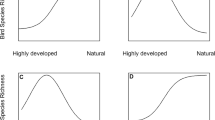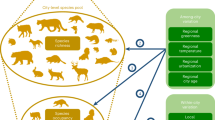Abstract
Urbanization is increasing worldwide with potentially important implications to biological diversity. I show that bird diversity is responsive to the reduction of forest cover associated with urbanization in the Seattle, WA, USA metropolitan area. Bird diversity peaks at intermediate levels of human settlement primarily because of the colonization of intermediately disturbed forests by early successional, native species. Extinction of native forest birds and colonization of settlements by synanthropic birds have lesser effects on the overall pattern of avian diversity with respect to the level of urbanization. However, extinction increases linearly with loss of forest and colonization by synanthropic species decreases curvilinearly with reduction of urbanization. These findings have biological, theoretical, and practical implications. Biologically, intermediate disturbance appears to drive diversity by increasing the heterogeneity of the local land cover. Theoretically, I present a graphical model and use it to derive testable hypotheses about how extinction and colonization are affected by urbanization to determine local diversity. Practically, maintaining high local diversity without reducing regional or global diversity will require planning so that the same landscapes are not promulgated everywhere. This will require cooperation among a diverse group of planners, ecologists, policy makers, home owners, educators, and activists.
Similar content being viewed by others
References
Alberti, M.A., Botsford, E. and Cohen, A. (2001) Quantifying the urban gradient: linking urban planning and ecology. In Avian Ecology and Conservation in an Urbanizing World (J.M. Marzluff, R. Bowman R. Donnelly, eds.), pp. 89–116. Kluwer Academic Publishers, Norwell, MA, USA.
Alberti, M.A., Marzluff, J.M., Shulenberger, E., Bradley, G., Ryan, C. and ZumBrunnen, C. (2003) Integrating humans into ecology: opportunities and challenges for urban ecology. BioScience 53, 1169–1179.
Alberti, M.A. and Marzluff, J.M. (2004) Ecological resilience in urban ecosystems: linking urban patterns to human and ecological functions. Urban Ecosystems 7, 241–265.
Baker, W.L. (1997) The r.le programs. University of Wyoming, Laramie. Available at: http://www.baylor.edu/~grass/gdp/terrain/r_le_22.html
Blair, R.B. (1996) Land use and avian species diversity along an urban gradient. Ecological Applications 6, 506–519.
Blair, R.B. (2001a) Birds and butterflies along urban gradients in two ecoregions of the United States: is urbanization creating a homogeneous fauna? In Biotic Homogenization (J.L. Lockwood and M.L. McKinney, eds.), pp. 33–56. Kluwer Academic/Plenum, New York, New York, USA.
Blair, R.B. (2001b) Creating a homogeneous avifauna. In Avian Ecology and Conservation in an Urbanizing World (J.M. Marzluff, R. Bowman and R. Donnelly, eds.), pp. 459–486. Kluwer Academic Publishers, Norwell, MA, USA.
Blair, R.B. (2004) The effects of urban sprawl on birds at multiple levels of biological organization. Ecology and Society 9, 2. [online] URL: http://www.ecologyandsociety.org/vol9/iss5/art2
Blewett, C.M. and Marzluff, J.M. (2005) Effects of urban sprawl on snags and the abundance and productivity of cavity-nesting birds. Condor 107, 677–692.
Bolger, D. (2001) Urban birds: population, community, and landscape approaches. In Avian Ecology and Conservation in an Urbanizing World (J.M. Marzluff, R. Bowman and R. Donnelly, eds.), pp. 155–178. Kluwer Academic Publishers, Norwell, MA, USA.
Booth, D.E. (1991) Estimating prelogging old-growth in the Pacific Northwest. Journal of Forestry 89, 25–29.
Botsford, E.R. (2000) Development of a modified land composition classification methodology utilizing LANDSAT thematic mapping and ancillary data. MS thesis, University of Washington, Seattle, Washington.
Brown, J.H. and Kodric-Brown, A. (1977) Turnover rates in insular biogeography: effect of immigration on extinction. Ecology 58, 445–449.
Bunnell, F.L. (1999) What habitat is an island? In: Forest Fragmentation: Wildlife and Management Implications(J.A. Rochelle, L.A. Lehmann and J. Wisniewski, eds.), pp. 1–31. Brill, Boston, MA, USA.
Connell, J.H. (1978) Diversity in tropical rainforests and coral reefs. Science 199, 1302–1310.
Czech, B. and Krausman, P.R. (1997) Distribution and causation of endangerment in the United States. Science 277, 1116–1117.
DeGraaf, R.M. and Wentworth, J.M. (1986) Avian guild structure and habitat associations in suburban bird communities. Urban Ecology 9, 399–412.
Donnelly, R. (2002) Design of habitat reserves and settlements for bird conservation in the Seattle metropolitan area. PhD dissertation, University of Washington, Seattle, Washington.
Donnelly, R. and Marzluff, J.M. (2004a) Importance of reserve size and landscape context to urban bird conservation. Conservation Biology 18, 733–745.
Donnelly, R. and Marzluff, J.M. (2004b) Designing research to advance the management of birds in urbanizing areas. In Proceedings of the 4th International Symposium on Urban Wildlife Conservation. May 1–5, 1999 (W. W. Shaw, L. K. Harris and L. Vandruff, eds.), pp. 114–122. University of Arizona Press. Tucson, AZ, USA.
Elvidge, C.D., Baugh, K.E., Kihn, E.A., Kroehl, H.W., and Davis, E.R. (1997) Mapping city lights wit nighttime data from the DMSP Operational Linescan System. Photogrammatic Engineering and Remote Sensing 63, 727–734.
Franklin, J.F. and Dyrness, C.T. (1988) Natural vegetation of Oregon and Washington. Oregon State University Press, Corvallis, OR, USA.
Hansen, A. J., Knight, R. L., Marzluff, J. M., Powell, S., Brown, K., Hernandez, P. and Jones, K. (in press) Effects of exurban development on biodiversity: Patterns, mechanisms, research needs. Ecological Applications.
Huston, M. (1979) A general hypothesis of species diversity. American Naturalist 113, 81–101.
Imhoff, M. L., Bounoua, L, DeFries, R., Lawrence, W.T., Stutzer, D., Tucker, C.J., and Rickets, T. (2004) The consequences of urban land transformation on net primary productivity in the United States. Remote Sensing of Environment 89, 434–443.
Johnston, R.F. (2001) Synanthropic birds of North America. In Avian Ecology and Conservation in an Urbanizing World (J.M. Marzluff, R. Bowman and R. Donnelly, eds.), pp. 49–68. Kluwer Academic Publishers, Norwell, MA, USA.
Kühn, I., Brandl, R., and Klotz, S. (2004) The flora of German cities is naturally species rich. Evolutionary Ecology Research 6, 749–764.
Lawrence, W.T., Imhoff, M. L., Kerle, N. and Stutzer, D. (2002) Quantifying urban land use and impact on soils in Egypt using diurnal satellite imagery of the Earth surface. International Journal of Remote Sensing 23, 3921–3937.
Leopold, A. 1933. Game Management. C. Scribner's Sons, New York, USA.
Lockwood, J.L., Brooks, T.M. and McKinney, M.L. (2000) Taxonomic homogenization of the global avifauna. Animal Conservation 3, 27–35.
Lomolino, M.V. (1996) Investigating causality of nestedness of insular communities: Selective immigrations or extinctions. Journal of Biogeography 23, 699–703.
Lomolino, M.V. (1999) A species–based, hierarchical model of island biogeography. In The Search for Assembly Rules in Ecological Communities(E.A. Weiher and P.A. Keddy, eds.), pp. 272-310. Cambridge University Press, New York, USA.Loreau, M. (2000) Biodiversity and ecosystem functioning: recent theoretical advances. Oikos 91, 3–17.
MacArthur, R.H. and Wilson, E.O. (1963) An equilibrium theory of insular zoogeography. Evolution 17, 373–387.
MacArthur, R.H. and Wilson, E.O. (1967) The Theory of Island Biogeography. Princeton University Press, Princeton, NJ, USA.
Marzluff, J. M. (2001) Worldwide urbanization and its affects on birds. In Avian Ecology and Conservation in an Urbanizing World (J.M. Marzluff, R. Bowman and R. Donnelly, eds.), pp. 19–47. Kluwer Academic Publishers, Norwell, MA, USA.
Marzluff, J.M. and Dial, K.P. (1991) Life history correlates of taxonomic diversity. Ecology 72, 428–439.
Marzluff, J.M. and Ewing, K. (2001) Restoration of fragmented landscapes for the conservation of birds: A general framework and specific recommendations for urbanizing landscapes. Restoration Ecology 9, 280–292.
Marzluff, J.M., Raphael, M.G. and Sallabanks, R. (2000) Understanding the effects of forest management on avian species. Wildlife Society Bulletin 28, 1132–1143.
Marzluff, J.M., McGowan, K.J., Donnelly, R.E. and Knight, R.L. (2001a) Causes and consequences of expanding American Crow populations. In Avian Ecology and Conservation in an Urbanizing World (J.M. Marzluff, R. Bowman and R. Donnelly, eds.), pp. 331–363. Kluwer Academic Publishers, Norwell, MA, USA.
Marzluff, J.M., Bowman, R. and Donnelly, R.E. (2001b) A historical perspective on urban bird research: trends, terms, and approaches. In Avian Ecology and Conservation in an Urbanizing World (J.M. Marzluff, R. Bowman and R. Donnelly, eds.), pp. 1–17. Kluwer Academic Publishers, Norwell, MA, USA.
Matlack, G.R. (1993) Sociological edge effects: spatial distribution of human impact in suburban forest fragments. Environmental Management 17, 829–835.
McGarigal, K., Cushman, S.A., Neel, M.C. and Ene, E. (2002) Spatial Pattern Analysis Program for Categorical Maps, FRAGSTATS 3.1. [Online, URL:<www.umass.edu/landeco/research/fragstats/fragstats.html>].
Olden, J.D. and Poff, N.L. (2003) Toward a mechanistic understanding and prediction of biotic homogenization. The American Naturalist 162, 442–460.
Olden, J.D. and Poff, N.L. (2004) Ecological processes driving biotic homogenization: testing a mechanistic model using fish faunas. Ecology 85, 1867–1875.
Olden, J.D., Poff, N.L., Douglas, M.R., Douglas, M.E. and Fausch, K.D. (2004) Ecological and evolutionary consequences of biotic homogenization. Trends in Ecology and Evolution 19, 18–24.
Parody, J.M., Cuthbert, F.J. and Decker, E.H. (2001) The effect of 50 years of landscape change on species richness and community composition. Global Ecology & Biogeography 10, 305–313.
Pimm, S.L. (2001) World According to Pimm. McGraw Hill, New York, USA.
Porter, E.E., Forschner, B.R. and Blair, R.B. (2001) Woody fragmentation and canopy fragmentation along a forest-to-urban gradient. Urban Ecosystems 5, 131–151.
Ralph, C.J., Geupel, G.R., Pyle, P., Martin, T.E. and Desante, D.F. (1993) Handbook of Field Methods for Monitoring Landbirds. U.S. Department of Agriculture, Forest Service, Pacific Southwest Research Station, Albany. General Technical Report PSW-GTR-144.
Reichard, S.H. and White, P. (2001) Horticulture as a pathway of invasive plant introductions in the United States. BioScience 51, 103–113.
Robinson, L., Newell, J.P. and Marzluff, J.M. (2005) Twenty-five years of sprawl in the Seattle region: growth management responses and implications for conservation. Landscape and Urban Planning 71, 51–72.
Roxburgh, S.H., Shea, K. and Wilson, J. B. (2004) The intermediate disturbance hypothesis: patch dynamics and mechanisms of species coexistence. Ecology 85, 359–371.
Sadik N. (1999) The State of World Population 1999—6 Billion: A Time for Choices. United Nations Population Fund, New York, USA (www.unfpa.org/swp/1999/pdf/swp99.pdf)
Sax, D.F. and Gaines, S.D. (2003) Species diversity: from global decreases to local increases. Trends in Ecology and Evolution 18, 561–566.
Scott, M.C. and Helfman, G.S. (2001) Native invasions, homogenization, and the mismeasure of integrity of fish assemblages. Fisheries 26, 6–15.
Sewell, S. R. and Catterall, S.P. (1998) Bushland modification and styles of urban development: Their effects on birds in southeast. Wildlife Research 25, 41–63.
Shafer, C.L. (1997) Terrestrial nature reserve design at the urban/rural interface. In Conservation in Highly Fragmented Landscapes(Schwartz, M.W., ed.), pp. 345–378. Chapman and Hall, New York, USA.
Statistical Package for Social Sciences, SPSS 10.1.3 (2001) SPSS, Chicago, USA.
Tress, B., Tress G., van der Valk, A. and Fry, G. (eds.). (2003) Interdisciplinary and Transdisciplinary Landscape Studies: potential and limitations. Delta, Wageningen.
Wilson, E.O. (2002) The Future of Life. Alfred A. Knopf: New York, USA.
Author information
Authors and Affiliations
Corresponding author
Rights and permissions
About this article
Cite this article
Marzluff, J.M. Island biogeography for an urbanizing world: how extinction and colonization may determine biological diversity in human-dominated landscapes. Urban Ecosyst 8, 157–177 (2005). https://doi.org/10.1007/s11252-005-4378-6
Issue Date:
DOI: https://doi.org/10.1007/s11252-005-4378-6




